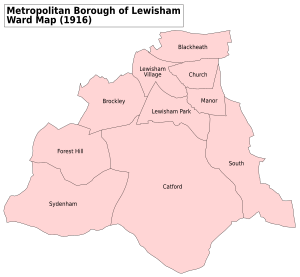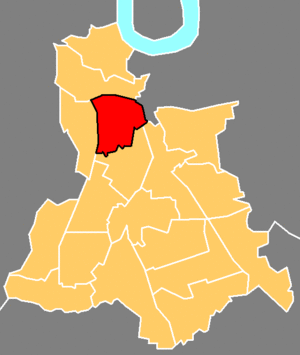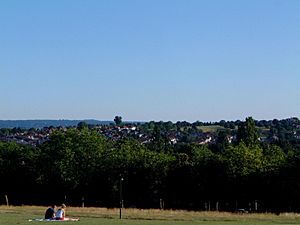Brockley facts for kids
Quick facts for kids Brockley |
|
|---|---|
 Brockley railway station |
|
| Population | 17,156 (2011 Census. Ward) |
| OS grid reference | TQ365745 |
| London borough | |
| Ceremonial county | Greater London |
| Region | |
| Country | England |
| Sovereign state | United Kingdom |
| Post town | LONDON |
| Postcode district | SE4 |
| Dialling code | 020 |
| Police | Metropolitan |
| Fire | London |
| Ambulance | London |
| EU Parliament | London |
| UK Parliament |
|
| London Assembly |
|
Brockley is a lively area in South London, England. It's part of the London Borough of Lewisham and is about 8 kilometers (5 miles) south-east of Charing Cross, a famous spot in central London. It's known for its green spaces, interesting history, and a strong community feel.
Contents
A Journey Through Brockley's Past
The name 'Brockley' comes from old English words. It might mean 'Broca's woodland clearing' or a 'stream by a wood'. It's even linked to badgers, as 'broc' is an old word for badger.
Brockley was once part of Kent county. In 1889, it became part of the Metropolitan Borough of Lewisham in the County of London. Later, in 1965, it joined the London Borough of Lewisham when Greater London was created.
Brockley started as a small farming village. It was near a large old pub called the "Brockley Jack", which is now home to the Brockley Jack Theatre. Crofton Park railway station opened nearby in 1892.
How Brockley Grew
Brockley railway station opened in 1871. Its location helped define the area we know as Brockley today. Places that used to be called Hatcham, New Cross, Telegraph Hill, and St Johns are now often thought of as part of Brockley.
The oldest house still standing in what's now northern Brockley is the "Stone House" on Lewisham Way. It was built in 1773 and is a very important historic building.
Brockley was once famous for its huge Victoria rhubarb and fruit orchards. A small river used to flow through the area, but it's now covered over.
Transport and Development
In 1809, the Croydon Canal brought industrial development to Brockley. This canal was later filled in and replaced by a railway line. Some of the oldest houses in Brockley, built around 1833, are on Coulgate Street near Brockley station. They were likely connected to the canal.
From 1872 to 1917, Brockley Lane railway station also served the area. You can still see parts of its old entrance at Brockley Cross.
In the late 1800s, the Tyrwhitt-Drake family developed the north side of Brockley. They built grand villas, large terraced houses, and semi-detached homes. Many wealthy factory owners and managers lived in these large houses. For example, Edwin Watts, who owned a company making mathematical instruments, lived on Breakspears Road. The famous actress Lillie Langtry also lived here.
Brockley has several beautiful churches. These include St Mary Magdalen's RC Church, Howson Road (1901), St Peter's, Wickham Rd (1870), and the Grade II listed St Andrews, Brockley Rd (1882). The latter has a special stained glass window remembering the New Cross Fire.
After World War I
After World War I, many of the large houses were divided into smaller flats. This was because wealthier families started moving to the outer suburbs. Small workshops also appeared in the mews (alleys) behind the big houses.
The Grade II listed Rivoli Ballroom is a unique and stunning building. It started as a cinema in 1913 and became a dance hall in 1951. It has been featured in many films and music videos. Famous artists like The White Stripes and Florence + the Machine have performed there.
During World War II, Brockley was in the path of bombers heading for the London docks. It suffered a lot of damage from bombs and V-2 rockets. The council flats built after the war show where some of this damage occurred. An anti-aircraft gun was even placed on Hilly Fields to defend against planes.
Brockley Today
After World War II, many large houses were divided into smaller homes. In the 1950s and 1960s, these homes welcomed the African-Caribbean population, many of whom worked in nearby Deptford. Other people came from Turkey, Cyprus, Italy, and South Asia.
Since the mid-1960s, artists, some linked to nearby Goldsmiths College, began moving into the large, affordable Victorian houses. This started a process of 'gentrification'. Much of north Brockley was made a Conservation Area in 1974 to protect its character.
Today, Brockley is one of the best-preserved Victorian suburbs in Inner London. It shows almost every style of 19th-century home, from grand Gothic Revival mansions to small workers' cottages.
The East London Line, now part of the London Overground network, opened in May 2010. It connects Brockley to north London and has encouraged new housing developments around Brockley station.
In 2000, the Brockley Cross Action Group was formed. They have helped restore Brockley Common and make other neglected areas greener.
Green Spaces to Explore
Brockley has several lovely open spaces. These include Blythe Hill, Brockley and Ladywell Cemeteries (now a nature reserve), and Hilly Fields. Hilly Fields was saved from development in the 1880s and 1890s by groups like the Commons Preservation Society and local people, including Octavia Hill, a founder of the National Trust.
In 1896, Hilly Fields was turned into a park. It became a regular meeting place for the Suffragette movement between 1907 and 1914.
Hilly Fields Highlights
The old West Kent Grammar School, now Prendergast Hilly Fields College, is a Grade II* listed building at the top of Hilly Fields. Its hall contains the 'Brockley murals'. These murals, created by Charles Mahoney, Evelyn Dunbar, and other students in the 1930s, are important examples of the Neo-Romantic art style. They show many local scenes.
A stone circle was built in Hilly Fields in 2000 as a millennium project by local artists. It even won an award! The Hilly Fields Midsummer Fayre is a popular annual community event that has been running for over 30 years. From Hilly Fields, you can enjoy wide views of London, from Canary Wharf to Crystal Palace.
West of the railway line, between Brockley and New Cross Gate stations, is the Brockley Nature Reserve. This ten-acre woodland is home to over 30 types of birds, including greater spotted woodpeckers. It's managed by the London Wildlife Trust. Gorne Wood is also nearby, a three-acre piece of ancient woodland.
Arts and Creativity in Brockley
Like its neighbor Telegraph Hill, Brockley is known as a hub for the arts in South London. In the mid-1960s, artists, musicians, and other creative people started moving here. They were drawn by the affordable Victorian houses and their large gardens, and the closeness to Goldsmiths College and Camberwell School of Art. Many artists have built studios in their gardens, and the yearly 'open studios' weekend is a great chance to visit them.
The Lewisham Art House is in a grand Edwardian building on Lewisham Way. It offers art classes, studios, and exhibition space. This Grade II listed building was once Deptford Library, funded by the generous industrialist Andrew Carnegie. It opened in 1914.
The Brockley Jack Theatre has been updated and is well-known for showing new plays. It's also home to the Brockley Jack Film Club. Every summer, local artists host the popular Brockley Open Studios weekend. Since 2004, Brockley has also hosted the Brockley Max performing arts festival, featuring many local musicians and singers. In 2015, the first Brockley Street Art Festival took place, adding more than twenty amazing murals to the area.
Famous People from Brockley
Many interesting people have lived in Brockley:
- Kate Bush, a famous singer, lived on Wickham Road.
- John Cale, a musician from the band Velvet Underground, lived in student halls on Wickham Road.
- Emily Davison, a brave suffragette, lived in Brockley for a time.
- John Galliano, a well-known fashion designer, grew up in Brockley.
- David Jones, a modernist poet and artist, was born in Brockley in 1895.
- Lily Langtry, an actress and friend of King Edward VII of the United Kingdom, lived on Wickham Road.
- Spike Milligan, the famous comedian, lived on Riseldine Road.
- Brian Molko, a musician who formed the band Placebo, lived in Brockley.
- Novelist, an English Grime MC and rapper, was nominated for a MOBO Awards in 2014.
- Harry Price, a psychic researcher famous for his work on Borley Rectory, lived on Harefield Road.
- David Rocastle, a professional footballer for Arsenal and England.
- John Stainer, a composer and organist, may have lived in Brockley. A local primary school is named after him.
- Chris Tarrant, a TV presenter, taught at a school in Brockley.
- Kae Tempest, a poet, performance artist, and musician.
- Bobby Valentino, a singer and violinist best known for "Young at Heart" by the Bluebells.
- Edgar Wallace, an author and original screenwriter of King Kong, lived in Tressillian Crescent. His fictional detective, J G Reeder, also lived in Brockley Road.
- Sir Willard White, a famous opera singer, once lived in Wickham Gardens.
- Henry Williamson, the writer who wrote Tarka the Otter, was born in Brockley in 1895. His novels describe Brockley in great detail.
- Ian Wright, a professional footballer for Arsenal and England, and now a sports pundit.
- Shaun Wright-Phillips, a footballer, grew up in Brockley.
Nearby Places
- Catford
- Crofton Park
- Deptford
- Forest Hill
- Greenwich
- Honor Oak
- Ladywell
- Lewisham
- New Cross
- Nunhead
- Peckham
- Telegraph Hill, Lewisham
Nearest Train Stations
- Brockley railway station
- Crofton Park railway station
- Forest Hill railway station
- Ladywell railway station
- Nunhead railway station
- St Johns railway station
Brockley in Books and Media
Brockley has been a setting or inspiration for many creative works:
- Two early novels by Henry Williamson describe Brockley in the late 1800s and early 1900s.
- Edgar Wallace's detective J. G. Reeder lived in Brockley Road. Wallace himself lived in Brockley for over 30 years.
- The Picturegoers, a novel by David Lodge, is set around a rundown cinema in 1950s Brockley.
- Blake Morrison's novel South of the River (2007) is set in Brockley.
- The Rivoli Ballroom has been featured in many films, TV shows, and music videos.
- The song "Last of the Lookers" by The Metros mentions Brockley.
- Laura Wilson, the main character in the comic book series The Wicked and The Divine, lives in Brockley at the start of the story.





